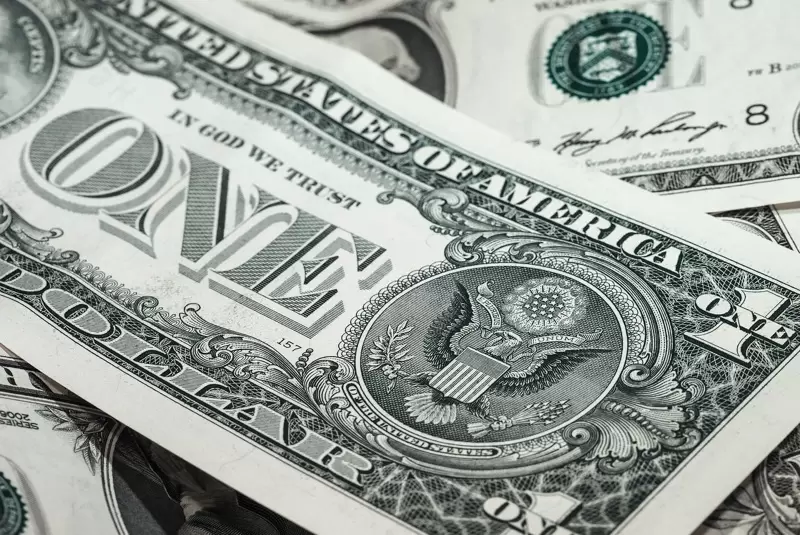De-dollarisation — a sharp decline in the use of the US dollar in global trade and financial transactions — could significantly reduce the demand for the greenback in national, institutional and corporate investments in international capital markets. To contextualise this trend, a historical analysis of the rise of the US dollar in the last hundred years and its global ramifications is warranted.
The US dollar entrenched its position as the global reserve currency after the Bretton Woods Agreement in 1944 in New Hampshire. The forty-four signatory nations of the Bretton Woods abandoned the proposals of Maynard Keynes for a multilateral International Clearing Union (ICU) to settle international payments by creating a multilateral currency, coined as the Bancor. Its monetary value was envisaged based on a price index of 30 widely traded commodities.
In pursuit of its ambitions for global domination by securing the dollar’s position as world money, the US government thwarted Keynes’s proposal through deft and covert political manoeuvres, primarily targeting Great Britain, then imperial power and custodian of the Sterling-Gold standard. To accomplish this, the US abruptly suspended loans to Britain under the wartime Lend-Lease Act and conducted complex negotiations to repay the $4.34 billion Anglo-American loan.
The objectives of the United States were manifold. Firstly, owning the remaining British overseas assets, redirecting the Imperial Preferential System’s £10 billion deposits — frozen sterling deposits of exporters like India and Egypt — locked in payment on British exports under preferential tariff agreements.
The US strategised on a market entry for American corporations into British and European markets, thereby gaining access to colonial raw materials and supply chains so that the blocked sterling deposits would be spent not only on British products but also on US exports. Finally, the US garnered Britain’s support for the newly formed international governance institutions—the World Bank and the IMF, designed by the US.
At the end of World War II, in 1945, the US had $20 billion in gold. By 1947, it had nearly 70 per cent of global monetary gold reserves in its vaults in Fort Knox. The war-torn continental Europe, especially Britain and Allied Forces, paid US creditors for arms and ammunition supplies in gold and dollar reserves. From a debtor economy at the start of World War I, the US economy benefited immensely from war, pulling it out of depression and by the end of the Second World War, the US economy had transformed itself into a world’s creditor backed by the power of the dollar, convertible into gold for $35 a troy ounce. Post-World War I, ruthless US foreign policies were instrumental in the nation’s ascent in the global world order.
Ancient societies — especially in the Near East — conducted periodic jubilees, where debtors were discharged of their dues, that allowed for a fresh start, a sort of tabula rasa. With the spread of the Roman empire, amnesty for debtors was abolished, and it became a pure contractual exchange, irrespective of the debtor’s personal or social consequences.
The US revived this Roman law post-World War I. Despite the British reminding the US to forgive Austria’s debts after the Napoleonic Wars, the US tenaciously pursued British and inter-allied repayments. After all, the financing was for destruction rather than production, and most of Europe lay in ruins. Consequently, Britain and the Allies insisted on staggering German reparations, which would be used as back-to-back payments to the United States.
Many industry leaders and economists across the world criticised the intransigency of the US government. Maynard Keynes published several articles on the Treaty of Versailles — that served as the roadmap for reparations and indemnities — as an economic disaster. Consequently, productive and profitable German lands bordering France were confiscated, and monetary reserves were appropriated by raising exchange rates for the US dollar as a mode of punishment so that German debt burdens would become insurmountable. This resulted in Weimar hyperinflation, crashing of the Reichsmark and rising of the Nazi party.
Bretton Woods gave birth to the dollar area where participating countries used the greenback for international settlements, trade invoicing, cross-border capital investments in stocks, bonds and securities and stores of value in forex reserves. While in the initial years, the US ran a current account surplus by exporting goods to war-ravaged European nations, controlling the world’s monetary system was enabled by running continually since 1951 the unfettered balance of payment deficits.
The Korean War and the Vietnam War saw US gold reserves depleted as the dollar was on the Gold Standard. The central banks, especially the French, converted the wartime US dollars into gold in the market.
After 1958, when European currencies became convertible and used for international payments, the vast hoard of dollar reserves in the US suffered a glut. The malefactor was US military spending in the two wars and the ensuing budget deficit from the scaling of US ordnance factories.
Since the 1960s, the balance of payment deficit has been military in character. President Richard Nixon abolished the Gold Standard in 1971 due to high inflation and depleting gold reserves. The Bretton Woods system collapsed but was replaced by a more efficacious and rewarding system for the US, with the treasury bond standard.
If central banks’ dollar reserves were spent on acquiring US gold during the Bretton Woods period, post-1971, sovereign nations began investing heavily in US treasury bonds. This gave the US economy an unrivalled advantage in permanently maintaining balance-of-payment deficits without losing the dollar’s value, thus counteracting the famous Triffin Dilemma.
Triffin’s Dilemma states that a balance of payments deficit is necessary to maintain liquidity for any currency to become a global reserve. Still, deficits will eventually erode the value of the currency. In the 1970s, the US negotiated with OPEC to channel the petrodollars back into the US financial system by buying treasury bonds.
With the Ronald Reagan era deregulation of banks and repealing the 1930 post-Depression Glass Steagall Act, the US circumvented the Triffin Dilemma by expanding the supply of US assets denominated in the US dollar or currencies easily convertible to the dollar and soliciting private financial demand. Eventually, private investments in US financial instruments far exceeded sovereign demand.
Stagnation in European markets in the mid-1970s drove the dollar to a precipitous slide. Flushed with petrodollars and without lucrative destinations to lend to, US banks and their allies looked to Third World markets, aided by the World Bank, and embarked on a lending spree.
By 1982, total debt to Third World countries—devoid of prompt due diligence of creditworthiness—skyrocketed to an unsustainable $327 billion. Rising interest due to monetary tightening in the US made these debt repayments unassailable.
It triggered the Third World Debt Crisis due to foreboding ills of US economic policies, visiting countries like Argentina, Mexico and Brazil. In the 1980s, the dollar’s decline and lower interest rates culminated in non-demand for US treasury bills, partially restored by then Federal Reserve chairman Paul Volker, who raised interest rates to 20% at one stage to stabilise the dollar and redeem budget deficits.
Alan Greenspan, the celebrated Federal Reserve chairman, introduced the ‘Greenspan Put,’ which allayed the fears of stock market declines of over 20% or becoming bearish. The policy’s provisions dictated that the Federal Reserve would intervene in a spiralling recession by reducing interest rates and through expansionary monetary policies like ‘Quantitative Easing,’ introduced under Ben Bernanke, which is asset purchase by the central bank.
The ‘Greenspan Put’ permitted stock/currency traders and investors to dabble in enormous risk, causing market bubbles, interconnections and market volatility. Financial engineering replaced industrial engineering.
The 1997 East Asian crisis, the dot-com bust in 2000, and the 2008 Great Recession are classic cases. American economist and Nobel laureate Joseph Stiglitz critiqued the Greenspan Put as privatising profits while socialising losses. When boom and bust cycles are short and frequent in free-market liberalist economies, it indicates a financial system’s structural flaws.
The United States maintaining a trillion-dollar deficit, denominated in US dollars, essentially means the world is paying for its monetary policies. It allowed the US to maintain their 800 military bases worldwide — the US went on an expansion spree after the Vietnam War — as the central banks were forced to hold dollar reserves for trade and finance.
The US spending dollars overseas comes back into the US financial system as capital investments in treasury bonds, stocks, debt and real estate investments. While the world earns US dollars by producing goods and services and trading those, the US has the luxury of printing money and issuing an ‘IOU’ to meet financial obligations.
But if any other country defaults on its foreign debt, the IMF will intervene, impose austerity measures impacting the wage-earning population, push the US policy of neoliberalisation and compliance with the privatisation of public entities, develop roadmaps for lifting capital controls, and demand that industrial sectors be opened up to American buyers.
If any country chooses to control their natural resources, their growth and investments in a pervasive nationalistic ethos, they are quickly derided as communists. A quintessential case study is the American misinterpretation of a nationalistic revolution in Vietnam as a communist revolution.
Regional trading blocs and countries wishing to withdraw from the dollar area will incur the wrath of the US administration through punitive tariffs as the President re-elects Donald Trump’s diatribe to impose 100% tariffs on BRICS nations aiming to diminish the dollar’s dominance.
However, the recent drive to de-dollarisation has been driven by US policy to use the dollar as a geopolitical weapon. When Russia invaded Ukraine, Washington confiscated and froze $300 billion of Russian US dollar forex reserves and threatened to take the Russian central bank off the SWIFT.
The US had coerced Great Britain to confiscate Venezuela’s 31 tonnes of gold worth $1.2 billion to overthrow the leftist and heavily sanctioned government of Nicolas Maduro and reinstate an American crony, Juan Guaidó.
The arbitrary withdrawal of the US from the Joint Comprehensive Plan of Action (JCPOA), also known as the Iran nuclear deal, and amplifying sanctions bear ample testimony to the economic warfare employed by the US to further their realpolitik agenda.
Weaponising the dollar is the US version of asymmetric warfare.
BRICS+ countries hold immense potential and are on a path to de-dollarisation, spearheaded by China, leading the change for a multipolar world. Though capital controls constrain the renminbi and are not freely convertible, Beijing has found a way of pumping the renminbi into the global financial system through swap lines. Following the wave of emerging technologies in finance, China has developed its proprietary Cross-Border Interbank Payment System and established bilateral swap lines with nearly 40 central banks to denominate oil contracts in renminbi.
In 2023, the French oil giant Total Energies and China National Offshore Oil Corporation concluded their first deal in liquified natural gas, invoiced in renminbi. The contract in local currency was routed through the Shanghai Petroleum and Natural Gas Exchange.
Another significant development was China reopening the gold window with the Shanghai Gold Exchange. It offers convertibility from offshore renminbi to gold. Russian oil products exported eastward and southward are all denominated in buyers’ local currencies. Zoltan Pozsar, the American economist, quipped recently: ‘That’s dusk for the petrodollar…and dawn for the Petro yuan.’
Reliance Industries, the Indian conglomerate and operator of the world’s largest refinery complex, has signed a one-year deal with Russia’s Rosneft to buy 3 million barrels of oil monthly in roubles. Intra BRICS+ trade has shown a remarkable increase in the oil and non-oil sectors since 2008, from 19 per cent to 31 per cent in 2023. The BRICS+ share of fuel trade in the emerging markets (EM) has risen substantially from 20 per cent to 37 per cent in 2023. These two areas present the greatest opportunity for de-dollarisation.
The Project mBridge is a collaborative Central Bank Digital Currency (CBDC) program led by the BIS Innovation Hub and central bankers from China, Thailand, and the UAE to facilitate seamless, fast and cost-effective cross-border payments without the intermediation of a US banking entity. Wholesale CBDCs could revolutionise instantaneous cross-border payments and local currency settlements (LCS) once organisation and governance protocols find consensus.
The European Monetary Union (EU) and its flagship Euro have emerged as strong contenders to the US Dollar since its inception on January 1, 1999. Currently, the Euro constitutes almost 20 per cent of all forex reserves held by central banks, whereas the USD share is steadily declining from 72 per cent in 2002 to 58.22 per cent in Q1 2024. The Euro accounts for half of EU exports, and in 2022, 52 per cent of all imports from non-EU countries and 59 per cent of all exports were invoiced in Euros.
The geopolitical economy of capitalism is fraught with inherent contradictions and haphazard logic of zero-sum outcomes. Therefore, no currency in a capitalist system can adorn the role of world money. Despite the greenback being a global reserve currency, it is also a national currency prioritising US national interest.
Historically, monetary policy diversions of the Federal Reserve had adversely impacted emerging-market and developing economies (EMDE). The recent interest rate hikes to combat US inflation sent shockwaves across EMDE, resulting in inordinate capital flights. It raised the cost of debt-servicing, forced an increase in yields in debt securities and triggered currency gyrations and other macroeconomic challenges that constrain the fiscal space for government investments in welfare programs. Hu Jintao, the Chinese premier in 2011, remarked, disconcertingly:
The monetary policy of the United States has a major impact on global liquidity and capital flows, and therefore, the liquidity of the US dollar should be kept at a reasonable and stable level.
Developed market currencies are not immune to changes to federal funds rate, as witnessed by the rapid sliding of the Japanese Yen, falling to a 34-year low of more than 160 per dollar in April 2024. IMF research concluded that a cessation of capital flows into or flight from any developing economy contracts its GDP by 4.5 per cent in the first year and a 2.2 per cent decline the following year.
Saudi Arabia was formally invited to join BRICS+ — KSA is hedging the decision — and their official entry could become a game changer in global geopolitics. Earlier in 2022, the Biden administration’s decision to fully deplete the US Strategic Petroleum Reserve irked King Mohammed bin Salman, estimated to have caused over $100 billion in lost revenues to Saudi Arabia owing to this energy policy shift.
The Gulf Arab states’ relations with the US, termed ‘petrodollar independence,’ an oil-for-security arrangement, could drastically be redefined if the BRICS+ leadership in Beijing and Moscow successfully persuades Saudi Arabia. In March 2023, Riyadh approved joining the Shanghai Cooperation Organisation, much to the chagrin of the US administration’s security concerns.
The pre-eminence of the US dollar will not be decimated overnight as it is involved in more than 85 per cent of foreign exchange transactions and is the captive currency in which half of global debt and cash is retained. However, a new monetary and world order is evolving dialectically, with dollar-aligned and non-aligned camps representing the US and China.
Geopolitical trade and currency wars will be fought in the future, with these two economic powers leading the fray. The wars will extend into technology, driven by artificial intelligence, money, and the control of commodities.
Gold will regain its status as the de facto political and economic expedient and safety net. All major countries have been stockpiling it in recent years, prominent ones being Russia, China, and India. China’s overtures in the Middle East, Africa and especially the Eurasian landmass will be critical in reshaping global order.
Europe is the biggest prize China seeks in this high-stakes game of the twenty-first century. De-dollarisation will probably accelerate during incumbent Donald Trump’s presidency.
The sociopolitical polarisation of American society and win-lose ‘America First’ policies may jeopardise the perceived stability of governance and diminish the dollar’s status as a haven. The corrosion of ‘soft power’ will inevitably crumble the whimsical citadels of ‘American Exceptionalism.’ De-dollarisation will be driven by technology and necessity. In retrospect, the greenback’s decline will be attributed to evolution rather than revolution.
-30-
Copyright©Madras Courier, All Rights Reserved. You may share using our article tools. Please don't cut articles from madrascourier.com and redistribute by email, post to the web, mobile phone or social media.Please send in your feed back and comments to [email protected]











